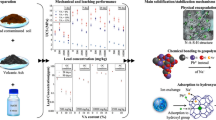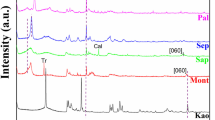Abstract
The preparation of porous materials from clay minerals by selective leaching is of interest because it yields residues with large specific surface areas that can be used as adsorbents of contaminants or as catalysts. Grinding produces surface modifications and therefore may significantly influence the leaching behavior. The aim of this paper is to study the effect of grinding and leaching on the structure of the vermiculite from Santa Olalla, Spain, using 57Fe Mössbauer spectroscopy, X-ray diffraction, infrared spectroscopy, and specific surface area (SBET) measurements. The study shows that grinding destroys the long range order of the vermiculite, but leaves the local structure in the environment of the Fe atoms intact, at least up to a grinding time of 10 min. The Mössbauer study shows that there is no Fe3+ in the tetrahedral sheets and that grinding does not lead to a significant oxidation of the structural Fe. Vermiculite ground for 4 min and leached with 1 M HCl solution at 80°C over a 24 h period was decomposed to X-ray amorphous silica with a very large specific surface area (SBET = 720 m2g−1) and with total pore volume of 0.586 cm3 g−1, whereas an unground sample leached with the same acid concentration yielded a specific surface area of only 504 m2 g−1. Most of the Mg2+ and Al3+ are removed from the ground sample after leaching with 1 M HCl, while large percentages of Fe2O3 remain with the X-ray amorphous silica. In unground vermiculite leached with 1 M HCl, a considerable amount of vermiculite remains in the residue. A sample ground for 4 min and treated with 0.25 M HCl also shows the typical vermiculite Mössbauer spectrum with an Fe2+/Fe3+ ratio similar to that of the unground vermiculite. The samples ground for 2 or 4 min and treated with 1 M HCl solution have an orange color and, according to the Mössbauer spectra, only Fe3+ remains. Mössbauer spectra of these samples taken at 4.2 K reveal the presence of akaganéite.
Similar content being viewed by others
References
Avilés, M.A. (1998) Síntesis de materiales cerámicos avanzados mediante la reducción carbotérmica de vermiculita. PhD thesis, Universidad de Sevilla, Spain.
Breen, C., Madejová, J., and Komadel, P. (1995) Characterization of moderately acid-treated, size-fractionated montmorillonites using IR and MAS NMR spectroscopy and thermal analysis. Journal of Materials Chemistry, 5, 469–474.
Breen, C., Zahoor, F.D., Madejová, J., and Komadel P. (1997) Characterization and catalytic activity of acid-treated, size-fractionated smectites. Journal of Physical Chemistry B, 101, 5324–5331.
Cseri, T., Békássy, S., Figueras, F., Cseke, E., de Menorval, L.C., and Dutartre, R. (1995) Characterization of clay-based K catalysts and their application in Friedel-Crafts alkylation of aromatics. Applied Catalysis A, 132, 141–155.
De la Calle, C., Suquet, H., and Pons, C.H. (1996) Evolution of benzylammonium-vermiculite and ornitine-vermiculite intercalates. Clays and Clay Minerals, 44, 68–76.
Farmer, V.C. (1974) The Infrared Spectra of Minerals. Monograph 4, Mineral Society, London. 539 pp.
Ferrow, E.A. 2002 Experimental weathering of biotite, muscovite and vermiculite: A Mössbauer spectroscopic study. Euopean Journal of Mineralogy, 14, 85–95.
Horvath, G. and Kawazoe, K. (1983) Methods for calculation of effective pore size distribution. I. Molecular sieve carbon. Journal of Chemical Engineering, Japan, 16, 420–475.
Kalinowski, B.E. and Schweda, P. (2007) Rates and non-stoichiometry of vermiculite dissolution at 22°C. Geoderma, 60, 367–385.
Komadel, P. (2003) Chemically modified smectite. Clay Minerals, 38, 127–138.
Kosuge, K., Shimada, K. and Tsunashima, A. (1995) Micropore formation by acid treatment of antigorite. Chemistry of Materials, 7, 2241–2246.
Madejová, J., Bujdak, J., Janek, M., and Komadel, P. (1998) Comparative FT-IR study of structural modifications during acid treatment of dioctahedral smectites and hectorite. Spectrochimica Acta A, 54, 1397–1406.
Murad, E. (1979) Mössbauer and X-ray data on β-FeOOH (akaganéite). Clay Minerals, 14, 273–283.
Novak, I. and Čičel, B. (1978) Dissolution of smectites in hydrochloric acid: II. Dissolution rate as a function of crystallochemical composition. Clays and Clay Minerals, 26, 341–344.
Okada, K., Shimai, A., Takei, T., Hayashi, S., Yasumori, A., and Mackenzie, K.J.D. (1998) Preparation of microporous silica from metakaolinite by selective leaching method. Microporous and Mesoporous Materials, 21, 289–296.
Okada, K., Arimitsu, N., Kameshima, Y., Nakajima, A., and Mackenzie K.J.D. (2005) Preparation of porous silica from chlorite by selective acid leaching. Applied Clay Science, 30, 116–124.
Okada, K., Arimitsu, N., Kameshima, Y., Nakajima, A., and Mackenzie, K.J.D. (2006) Solid acidity of 2:1 type clay minerals activated by selective leaching. Applied Clay Science, 31, 185–193.
Pérez-Maqueda, L.A., Caneo, O.B., Poyato, J., and Pérez-Rodriguez J.L. (2001) Preparation and characterization of micron and submicron-sized vermiculite. Physics and Chemistry of Minerals, 28, 61–66.
Pérez-Maqueda, L.A., Jiménez de Haro, M.C., Poyato, J., and Pérez-Rodríguez, J.L. (2004) Comparative study of ground and sonicated vermiculite. Journal of Materials Science, 39, 5347–5351.
Pérez-Rodríguez, J.L. Pérez-Maqueda, L.A., Poyato, J., and Lerf, A. (2003) Layer modification by mechanical treatment of the Santa Olalla vermiculite. Solid State Phenomena, 90–91, 515–520.
Rhodes, C.N. and Brown, D.B. (1995) Autotransformation and aging of acid-treated montmorillonite catalysts: a solid state 27Al NMR study. Journal of the Chemical Society, Faraday Transactions, 91, 1031–1035.
Rancourt, D.G., Dong, M.Z., and Lalonde, A.E. (1992) Mössbauer spectroscopy of tetrahedral Fe3+ in trioctahedral micas. American Mineralogist, 77, 34–43.
Sánchez-Soto, P.J., Ruiz-Conde, A., Avilés, M.A., Justo, A., and Pérez-Rodríguez, J.L. (1995) Mechanochemical effects on vermiculite and its influence on the synthesis of nitrogen ceramics. in: Ceramics: Charting the Future (P. Vicenze editor). Techna Srl., Spain.
Shinoda, T., Onaka, M., and Izumi, Y. (1995) Proposed models of mesopore structures in sulfuric acid-treated montmorillonites and K10. Chemistry Letters, 7, 495–496.
Suquet, H. (1989) Effect of dry grinding and leaching on the crystal structure of chrysotile. Clays and Clay Minerals, 37, 439–445.
Suquet, H., Chevalier, S., Marcilly, C., and Barthomeuf, D. (1991) Preparation of porous materials by chemical activation of the Llano vermiculite. Clays and Minerals, 26, 49–60.
Suquet, H., Franck, R., Lambert, J.F., Elsass, C.M., and Chevalier, S. (1994) Catalytic properties of two pre-cracking matrices: a leached vermiculite and Al-pillared saponite. Applied Clay Science, 8, 349–364.
Temuujin, J., Okada, K., Jadamboa, T.S., Mackenzie K.J.D., and Amarsanoa, J. (2002) Effect of grinding on the preparation of porous material from talc by selective leaching. Journal of Materials Science Letters, 21, 1607–1609.
Temuujin, J., Okada, K., and Mackenzie, K.J.D. (2003a) Preparation of porous silica from vermiculite by selective leaching. Applied Clay Science, 22, 187–195.
Temuujin, J., Okada, K., Jadambae, T.S., Mackenzie, K.J.D., and Amarsanaa, J., (2003b) Effect of grinding on the leaching behaviour of pyrophyllite. Journal of the European Ceramic Society, 23, 1277–1282.
Vicente-Rodríguez, M.A., Suarez, M., Bañares-Muñoz, M.A., and González, J.D. (1996) Comparative FT-IR. Study of the removal of octahedral cations and structural modifications during acid treatment of several silicates. Spectrochimica Acta A, 52, 1685–1694.
Author information
Authors and Affiliations
Corresponding author
Rights and permissions
About this article
Cite this article
Maqueda, C., Romero, A.S., Morillo, E. et al. The behavior of Fe in ground and acid-treated vermiculite from Santa Olalla, Spain. Clays Clay Miner. 56, 380–388 (2008). https://doi.org/10.1346/CCMN.2008.0560307
Received:
Revised:
Published:
Issue Date:
DOI: https://doi.org/10.1346/CCMN.2008.0560307




